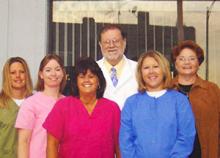John Helscher, DDS of Washington, Iowa, has been in practice for 32 years. Four years ago he became a Sterling client and his production and collections have nearly doubled since. An essential ingredient in his success was having his wife, Mary Lynn, quit her job as project director for a national testing firm and become his office manager. She accompanied him to Glendale to train for her new position.
“It was pretty clear that I wasn’t going to be able to sit in a dental chair producing and run the office at the same time, so she agreed to come on board as the office manager” he says. “The nice thing was that I didn’t have to go out and find someone who had the best interests of the office at heart.”
Although she had never worked in a dental office previously, after her Sterling training, she immediately began taking over the administrative duties of the practice, freeing up Dr. Helscher to treat patients and wear the owner hat.
“If I had an idea I could just say, ‘Hey, Mary Lynn, run with this,’ and I wouldn’t have to worry about it getting done,” he says. “It took all the pressure off me.”
“We found Sterling because John and I felt that we needed to get a handle on how to manage an office,” says Mary Lynn. “I knew about managing projects for testing, but that didn’t necessarily mean I knew about a dental office. The training made a lot of sense to me, and I knew that if we used the Sterling system we could achieve the results we were looking for.”
“But what has been most helpful to me is the fact that, after you take those courses, Sterling doesn’t leave you high and dry. You have a consultant to help you implement what you have learned in the courses,” she continues. “That is very critical and is one of Sterling’s strong points. You don’t just take a course and then go home and try to do it all on your own. Instead you get continuing guidance to make sure you do it right.”
One of the aspects she particularly liked was learning about the tone scale, which has helped her in managing the staff as well as closing patients on obtaining their full treatment programs.
“In all areas of life, it really helps to know where people are on the tone scale,” she says.
The training also helped her with delineating the hats in the office, training the staff on them and ensuring that everyone in the office is doing what they should. This even applies to the doctor and herself.
“The fact that we went through this program together put us on the same page,” she explains. “If I’m not doing what I’m supposed to do, he knows it; and if he’s not doing what he’s supposed to, I know it. It is a checks and balances thing.”
“The office manager and the owner have to be on the same page; they just have to,” agrees Dr. Helscher. “That’s where Sterling has really, really paid dividends for us. We went out there together; got trained together; came home and implemented things together. We are on the same system. If I had to hire a new office manager and train her in the system, I would send her out to Glendale and let Sterling do the job. That is the easiest way to train an office manager, and it’s not nearly as expensive as spending two or more years training one yourself.”

